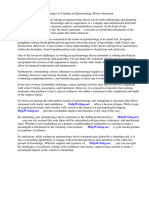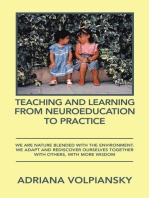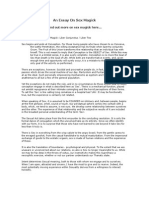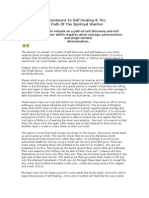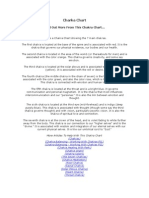0 ratings0% found this document useful (0 votes)
233 viewsThird Eye
Third Eye
Uploaded by
nawazThe document discusses the concept of the "third eye" which is described as a gateway to inner realms and higher levels of consciousness. It refers to the third eye in various spiritual traditions like Hinduism, Buddhism, and Christianity. The text is about a school that teaches methods for developing the third eye through direct experience in order to gain experiential knowledge of inner realms rather than relying on beliefs or dogma. The school has developed precise techniques and a methodology for systematically exploring consciousness and comparing experiences to bring objectivity to subjectivity. Over time this has resulted in extensive documentation of insights into a model of consciousness.
Copyright:
© All Rights Reserved
Available Formats
Download as DOC, PDF, TXT or read online from Scribd
Third Eye
Third Eye
Uploaded by
nawaz0 ratings0% found this document useful (0 votes)
233 views1 pageThe document discusses the concept of the "third eye" which is described as a gateway to inner realms and higher levels of consciousness. It refers to the third eye in various spiritual traditions like Hinduism, Buddhism, and Christianity. The text is about a school that teaches methods for developing the third eye through direct experience in order to gain experiential knowledge of inner realms rather than relying on beliefs or dogma. The school has developed precise techniques and a methodology for systematically exploring consciousness and comparing experiences to bring objectivity to subjectivity. Over time this has resulted in extensive documentation of insights into a model of consciousness.
Original Description:
te
Original Title
Third eye
Copyright
© © All Rights Reserved
Available Formats
DOC, PDF, TXT or read online from Scribd
Share this document
Did you find this document useful?
Is this content inappropriate?
The document discusses the concept of the "third eye" which is described as a gateway to inner realms and higher levels of consciousness. It refers to the third eye in various spiritual traditions like Hinduism, Buddhism, and Christianity. The text is about a school that teaches methods for developing the third eye through direct experience in order to gain experiential knowledge of inner realms rather than relying on beliefs or dogma. The school has developed precise techniques and a methodology for systematically exploring consciousness and comparing experiences to bring objectivity to subjectivity. Over time this has resulted in extensive documentation of insights into a model of consciousness.
Copyright:
© All Rights Reserved
Available Formats
Download as DOC, PDF, TXT or read online from Scribd
Download as doc, pdf, or txt
0 ratings0% found this document useful (0 votes)
233 views1 pageThird Eye
Third Eye
Uploaded by
nawazThe document discusses the concept of the "third eye" which is described as a gateway to inner realms and higher levels of consciousness. It refers to the third eye in various spiritual traditions like Hinduism, Buddhism, and Christianity. The text is about a school that teaches methods for developing the third eye through direct experience in order to gain experiential knowledge of inner realms rather than relying on beliefs or dogma. The school has developed precise techniques and a methodology for systematically exploring consciousness and comparing experiences to bring objectivity to subjectivity. Over time this has resulted in extensive documentation of insights into a model of consciousness.
Copyright:
© All Rights Reserved
Available Formats
Download as DOC, PDF, TXT or read online from Scribd
Download as doc, pdf, or txt
You are on page 1of 1
Third eye, the gate that leads within
The third eye is universal. In the Indian tradition it is
jnana-chaksu, the eye of knowledge, the seat of the
antar-guru, or 'teacher inside'. In Buddhist art, it is
figured as a gem on the forehead of buddhas. And in the
words of the Gospels,
The light of the body is the eye: if therefore
thine( thickest) eye be single, thy whole body shall be
full of light. (Matthew 6:22)
The third eye, in essence, is the portal to inner
realm(kingdom). The Upanishads describe a human
being as a city with ten gates. Nine gates (eyes, nostrils, ears, mouth, urethra, anus) lead
to the outside world. The tenth gate, the third eye, opens onto inner worlds: the whole
spectrum of levels of consciousness.
The approach of the school is resolutely experiential. It is designed for people who
cannot be satisfied only with other people's opinions and beliefs, but wish to gain firsthand experience of levels of consciousness. In short, it is not what you presume or
accept as true that will bring about transformation, but what you experience directly.
Clairvision therefore always emphasizes the superiority of experiential knowledge over
belief and dogma.
The Clairvision work therefore begins with a systematic method for developing the third
eye, as a foundation for a direct experience of inner realms.
Here, nothing vague! The indications are clear, the techniques precise, the first
results immediate and tangible.
Through the third eye work students develop their own mapping of consciousness: a
systematic if not scientific method of inner exploration.
The idea that experiences of consciousness are vague and incommunicable has absolutely
no place in this work. On the contrary, the school has developed a whole methodology for
people to compare experiences and exchange observations, thereby bringing objectivity
into the realm of subjectivity.
Since the creation of the school in 1987, this has resulted in the gathering of a huge
amount of material, documented in the form of books and lectures. A sophisticated
model of consciousness has emerged, principles of which are presented in A Language
to Map Consciousness, by Samuel Sagan.
You might also like
- Occult Cosmology by Bruce LyonDocument214 pagesOccult Cosmology by Bruce LyonJohn SkybirdwalkingbearNo ratings yet
- Numerology Clifford CH EasleyDocument49 pagesNumerology Clifford CH EasleyPriyesh Mandhanya100% (5)
- Bruce Lyon - Occult CosmologyDocument55 pagesBruce Lyon - Occult Cosmologyeponymos100% (1)
- Universal SufismDocument29 pagesUniversal SufismnawazNo ratings yet
- Consciousness in The UpanishadsDocument13 pagesConsciousness in The UpanishadsAditya Kumar100% (1)
- Changing Discourses in Buddhist Philosophy of Knowledge and PerceptionDocument14 pagesChanging Discourses in Buddhist Philosophy of Knowledge and Perceptionavinash6686No ratings yet
- Practicing The 3rd EyeDocument12 pagesPracticing The 3rd EyeFredrik Markgren0% (1)
- Develop Mirror-Like WisdomDocument11 pagesDevelop Mirror-Like WisdomANKUR BARUA100% (2)
- Fourth Dimension Manly P HallDocument6 pagesFourth Dimension Manly P HallAaronNo ratings yet
- Mantiq Al-MuzhafrDocument75 pagesMantiq Al-MuzhafrcontentedselfNo ratings yet
- Subject Object Vs Wisdom Knowledge 3 SatyasDocument310 pagesSubject Object Vs Wisdom Knowledge 3 SatyasSushil SharmaNo ratings yet
- The Methods of PhilosophyDocument3 pagesThe Methods of PhilosophyXhanynne CocoyNo ratings yet
- Tausin 9 3Document9 pagesTausin 9 3Nguyễn Thanh BìnhNo ratings yet
- Advaita PhenomenologyDocument31 pagesAdvaita PhenomenologyvinayNo ratings yet
- Body Senses and ArchitectureDocument167 pagesBody Senses and ArchitecturekockioNo ratings yet
- My NoteDocument6 pagesMy NoteDonald B. OliverNo ratings yet
- Kante Theory of KnowledgeDocument13 pagesKante Theory of KnowledgeIddi KassiNo ratings yet
- Ilmu Pengetahuan Dari John Locke Ke Al-Attas: Izzatur Rusuli Dan Zakiul Fuady M. DaudDocument11 pagesIlmu Pengetahuan Dari John Locke Ke Al-Attas: Izzatur Rusuli Dan Zakiul Fuady M. DaudPutrioktalizaNo ratings yet
- Jornal PresentationDocument15 pagesJornal PresentationLina Nachin TimanoyoNo ratings yet
- MontessoriDocument15 pagesMontessorixiaotong yinNo ratings yet
- Written Report - PhiloDocument71 pagesWritten Report - PhiloBrenda O. MasuangatNo ratings yet
- The Mystic's Path: Rituals and Spells for Third Eye AwakeningFrom EverandThe Mystic's Path: Rituals and Spells for Third Eye AwakeningRating: 5 out of 5 stars5/5 (1)
- Indic Visions in An Age of Science by Varadaraja VDocument18 pagesIndic Visions in An Age of Science by Varadaraja VHoang NguyenNo ratings yet
- Buddhist Psychology of PerceptionDocument8 pagesBuddhist Psychology of PerceptionHoang NguyenNo ratings yet
- In the School-Room Chapters in the Philosophy of EducationFrom EverandIn the School-Room Chapters in the Philosophy of EducationRating: 3 out of 5 stars3/5 (1)
- Four General or World PhilosophiesDocument6 pagesFour General or World PhilosophiesKris Bernadette Perez DavidNo ratings yet
- Kena UpanishadDocument46 pagesKena UpanishadmuruganarNo ratings yet
- Philosophies of EducationDocument12 pagesPhilosophies of EducationEarl Longyapon FranciscoNo ratings yet
- How I Teach Anthroposophy 2011Document8 pagesHow I Teach Anthroposophy 2011Arve MathisenNo ratings yet
- Rudolf Steiner-Spiritual Science and The Art of Healing PDFDocument21 pagesRudolf Steiner-Spiritual Science and The Art of Healing PDFItay Raphael Oron100% (1)
- Module 1 - The Tibetan Book of The Dead (Reading)Document12 pagesModule 1 - The Tibetan Book of The Dead (Reading)Daniel RampacekNo ratings yet
- Birds ProcessDocument3 pagesBirds ProcessaemNo ratings yet
- Awakening The Inner Sense - Some Methods & Meditation ObjectsDocument7 pagesAwakening The Inner Sense - Some Methods & Meditation ObjectsDilip KiningeNo ratings yet
- Rhyme, Reason and Learning: Meaning Making." When The Brain Processes The Sensory Inputs, It Draws Some ConclusionsDocument2 pagesRhyme, Reason and Learning: Meaning Making." When The Brain Processes The Sensory Inputs, It Draws Some ConclusionsnattmurNo ratings yet
- TEORI FENOMENOLOGI Little JohnDocument2 pagesTEORI FENOMENOLOGI Little JohnAsharie ajaNo ratings yet
- Correia and Dalagana - Chaier 3 - A Model For Artistic ResearchDocument88 pagesCorreia and Dalagana - Chaier 3 - A Model For Artistic ResearchccmusicaedarteNo ratings yet
- Plato's Theory of Education: It's Applicability in Teaching Methodology in Tanzania Secondary SchoolsDocument8 pagesPlato's Theory of Education: It's Applicability in Teaching Methodology in Tanzania Secondary SchoolsInternational Journal of Arts, Humanities and Social Studies (IJAHSS)No ratings yet
- Functions of The Eight Kinds of Consciousness in YogacaraDocument14 pagesFunctions of The Eight Kinds of Consciousness in YogacaraANKUR BARUA100% (3)
- OMISAKIN ProjectDocument62 pagesOMISAKIN ProjectMarie Prisc ShellNo ratings yet
- Chapter 3 of The Book Philosophy and Education by George R Knight Discusses The Traditional Philosophies and Education It Starts of by Discussing The Function and Limitations and LabelsDocument3 pagesChapter 3 of The Book Philosophy and Education by George R Knight Discusses The Traditional Philosophies and Education It Starts of by Discussing The Function and Limitations and LabelsSam100% (1)
- Principles and Theories of Language Acquisition and Learning: Philosophies of EducationDocument28 pagesPrinciples and Theories of Language Acquisition and Learning: Philosophies of EducationVenira Fritz LipaNo ratings yet
- Four General or World Philosophies: IdealismDocument7 pagesFour General or World Philosophies: IdealismPatriot DolorNo ratings yet
- Role of Reasoning in Research MethodologyDocument7 pagesRole of Reasoning in Research MethodologyDr.Ramanath PandeyNo ratings yet
- Rudolf Steiner - Spiritual Science and The Art of HealingDocument21 pagesRudolf Steiner - Spiritual Science and The Art of Healingpilar_maldonado_2No ratings yet
- General PhilosophiesDocument4 pagesGeneral PhilosophiesFaizan FaizanNo ratings yet
- Awakening The Inner SenseDocument9 pagesAwakening The Inner SenseCharity Masters100% (1)
- Theories of KnowledgeDocument4 pagesTheories of Knowledgeshazzyshan1No ratings yet
- Discovery of The Child - by Maria Montessori BOOK All PagesDocument492 pagesDiscovery of The Child - by Maria Montessori BOOK All PagesRazieh ToonyNo ratings yet
- Anumana PDFDocument130 pagesAnumana PDFdronregmi100% (1)
- Keynote Speaker #2Document11 pagesKeynote Speaker #2Vivi Khafilatul JannahNo ratings yet
- Voices of Silence in Pedagogy: Art, Writing and Self-EncounterDocument19 pagesVoices of Silence in Pedagogy: Art, Writing and Self-EncounterbethsuniNo ratings yet
- Epistemology Thesis StatementDocument5 pagesEpistemology Thesis Statementoxylhkxff100% (2)
- "The Third Eye: A Comprehensive Guide to Spiritual Development and Personal Growth"From Everand"The Third Eye: A Comprehensive Guide to Spiritual Development and Personal Growth"No ratings yet
- Facts Truth and Objectivity Today PDFDocument17 pagesFacts Truth and Objectivity Today PDFHIBA komorebiNo ratings yet
- Unfolding the Eightfold Path: A Contemporary Zen PerspectiveFrom EverandUnfolding the Eightfold Path: A Contemporary Zen PerspectiveNo ratings yet
- 11 AwakeningtheInnerSenseSomeMethodsMeditationObjectsBW PDFDocument7 pages11 AwakeningtheInnerSenseSomeMethodsMeditationObjectsBW PDFDilip Kininge100% (1)
- Teaching and Learning from Neuroeducation to Practice: We Are Nature Blended with the Environment. We Adapt and Rediscover Ourselves Together with Others, with More WisdomFrom EverandTeaching and Learning from Neuroeducation to Practice: We Are Nature Blended with the Environment. We Adapt and Rediscover Ourselves Together with Others, with More WisdomNo ratings yet
- Bab IiDocument26 pagesBab IiHabral El-AttasNo ratings yet
- Lessons of Solitude The Awakening of Aesthetic SensibilityDocument15 pagesLessons of Solitude The Awakening of Aesthetic SensibilityrienNo ratings yet
- Philosophically, There Is A Necessary Nexus Between Being As The Object of Knowledge and KnowledgeDocument4 pagesPhilosophically, There Is A Necessary Nexus Between Being As The Object of Knowledge and KnowledgeAJHSSR JournalNo ratings yet
- Basic RitualDocument5 pagesBasic RitualnawazNo ratings yet
- Find Out More About Precognitive Dreams & Premonitions Here.Document5 pagesFind Out More About Precognitive Dreams & Premonitions Here.nawazNo ratings yet
- An Essay On Sex MagickDocument7 pagesAn Essay On Sex MagicknawazNo ratings yet
- (... Continued From REM Sleep & Remembering Dreams PT 1Document4 pages(... Continued From REM Sleep & Remembering Dreams PT 1nawazNo ratings yet
- Dreams: Dream FactsDocument2 pagesDreams: Dream FactsnawazNo ratings yet
- Aromatherapy: - History & Modern Use of Essentail OilsDocument8 pagesAromatherapy: - History & Modern Use of Essentail OilsnawazNo ratings yet
- Dream DictionaryDocument3 pagesDream DictionarynawazNo ratings yet
- Seven Chakras: Find Out More About Your Seven Chakras Here..Document3 pagesSeven Chakras: Find Out More About Your Seven Chakras Here..nawazNo ratings yet
- Commitment To Self HealingDocument3 pagesCommitment To Self HealingnawazNo ratings yet
- Lucid Dreams: False Awakening and LucidityDocument3 pagesLucid Dreams: False Awakening and LuciditynawazNo ratings yet
- Doreen VirtueDocument4 pagesDoreen VirtuenawazNo ratings yet
- Second Chakra / Sacral Chakra: Find Out More About Your Second Chakra Here..Document2 pagesSecond Chakra / Sacral Chakra: Find Out More About Your Second Chakra Here..nawazNo ratings yet
- Crystal Healing For The Golden AgeDocument5 pagesCrystal Healing For The Golden AgenawazNo ratings yet
- Interview With DR Deepak ChopraDocument3 pagesInterview With DR Deepak ChopranawazNo ratings yet
- Introduction To ChakrasDocument2 pagesIntroduction To ChakrasnawazNo ratings yet
- Charka Chart: Find Out More From This Chakra Chart..Document2 pagesCharka Chart: Find Out More From This Chakra Chart..nawazNo ratings yet
- Chakras: Find Out More About Chakras Here..Document2 pagesChakras: Find Out More About Chakras Here..nawazNo ratings yet




















































